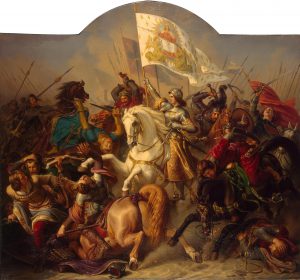
¿Alguna vez ustedes se han encontrado con un hispanohablante que usaba una palabra diferente de la que conocen? ¿O tal vez pronunciaba una palabra de manera diferente a la forma en que la dicen ustedes? Entre los dialectos del español, hay diferencias fonéticas, o diferencias en la pronunciación. Este episodio va a presentar las diferencias dialectales entre tres países latinoamericanos: El Salvador, Honduras y México. Únanse a Analyssa y Justine en su búsqueda para obtener una comprensión más profunda de los fenómenos de la aspiración y la elisión del sonido /s/. La aspiración de /s/ a [h] es cuando /s/ en una palabra se pronuncia como el sonido inglés “h”, como en la palabra “hi”. Por ejemplo, la palabra “estados” puede pronunciarse como [eh.’ta.ðoh]. La elisión de la /s/ consiste en eliminarla por completo, como si la /s/ no existiera. Por ejemplo, si se pronuncia “estados” como [e.’ta.ðo]. La aspiración y la elisión de /s/ son comunes tanto en El Salvador como en Honduras. Pero, ¿qué hay de México? En México, es muy raro que un hablante nativo de español pronuncie el sonido /s/ con alguna aspiración o elisión. Uno de los principales enfoques en este podcast será cómo reaccionan nuestros huéspedes mientras escuchan diferentes dialectos del español de estos tres países. ¿Pueden predecir sus reacciones?
Referencias
Lingo Mastery. (2018). Spanish short stories for beginners: 20 captivating short stories to learn Spanish and grow your vocabulary The fun way! CreateSpace Independent Publishing Platform. https://usa1lib.org/book/3675982/0518ed?dsource=recommend
Lipski, J. M. (2014). El español de América (S. Iglesias Recuero, Trans.). Cátedra.
Morgan, T.A. (2010). Sonidos en contexto: Una introducción a la fonética del español con especial referencia a la vida real. Yale University Press.
Quora. (n.d.). How different is Spanish spoken in El Salvador from other Spanish dialects? https://www.quora.com/How-different-is-Spanish-spoken-in-El-Salvador-from-other-Spanish-dialects
Resnick, M. C. (2010). Phonological variants and dialect identification in Latin American Spanish. De Gruyter.
Spanac. (2021, June 9). Transition bells sound effect. Free Sounds Library. https://www.freesoundslibrary.com/transition-bells-sound-effect/



13 comments
Jazlynn Ajel
Hola! Me gusto escuchando a su podcast, fue muy interesante escuchando a los dialectos diferentes. Creo que es muy fascinante que los tres países hablan lo mismo lenguaje pero la pronunciación es un poquito diferente. Me di cuenta de que el español puede ser diferente entre las países hispanohablantes cuando una mujer de Venezuela comenzó a trabajar conmigo y ella usa palabras diferentes que los mexicanos. Por ejemplo, ella dice “ya coloqué las salsas” pero los mexicanos nada más dicen “ya puse las salsas” o “ya están las salsas”.
Nicole Estrada
Hola Justine y Analyssa! Pensé que tu podcast era muy interesante. Nunca me di cuenta de cómo los diferentes países de habla hispana tienen diferentes palabras o dichos en sus países particulares. Aprendí muchas cosas de tu podcast. Específicamente en cómo se pronuncian ciertas palabras en los países específicos que mencionaste, como El Salvador, Honduras y México. ¡Buen trabajo!
Jose Ignacio Guerrero Donoso
Hola Justine y Analyssa,
me encanto el podcast de ustedes. Porque, no solo fue interesante, pero me enseñaste algo que yo antes no sabia. Además, yo te digo esto, porque yo siento que como Latinos nosotros no nos damos cuenta de estas pequeñas cosas en nuestro idioma; y tampoco nos damos cuenta que una palabra(s) que decimos en nuestro país a de ser muy diferente en otro país hispano hablante.
Amanda Uribe
Hola! Franastico trabjo! Siempre es bueno escuchar el idioma y el dialecto de diferentes países. Es interesante como los diferentes dialectos tienen mas elisiones en una conversación normal. Me gusta la diferencia entre conversación formal y informal. Es mas facil para aprender como y cuando los hablantes nativos usan elisiones.
Priscilla Vargas
Hola chicas, muy buen hecho. Me impresone que podieron obtener tres chicas para este estudio desde tres paises. Fue bien interesante como la /s/ se pronuncia o si elimina dependio desde donde viene la persona. Tengo amigas puertorriqueños y siempre me dicen que tienen, “lazy tongue”, lengua perezosa cuando no las entiendo. Aunque hablamos diferente en la manera de pronunciar si no estoy poniendo atencion a veces ni me fijo si pronuncian la /s/ o la elminan. Creo que en una conversación normal no lo noto porque mi mente llena lo que debo or creo que debo escuchar. Este estudio de la /s/ es fascinante.
Brianna Rodriguez
¡Hola Justine y Analyssa! Me encanta cómo tu podcast incluyó a tres estudiantes de diferentes países de habla hispana. Es interesante examinar las diferencias en su pronunciación y tono, especialmente cuando se analizan todos simultáneamente. ¡Buen trabajo en el podcast!
Samantha Bonillas
Hola Justina y Analyssa. Gracias por compartir con nosotros las variaciones diferentes del español y comparándolos con inglés sobre el sonido sombre la /s/. Algo interesante que me gusto del episodio es cuando Bella anotó que la lengua de Elisa suena ‘más suave’ por que nosotros mismos no anotamos estos detalles pero otros hispanohablantes si. ¡Muy bien con el episodio. Aprendí mucho!
Melyna Martinez
Hola Analyssa y Justine, me encante el tema y como explora variaciones del español y su comparación al inglés con el sonido de la S. La verdad es impresionante ver las diferencias en solo la lengua del español, como unas regiones ignoran el sonido y otros no. Las Mexicanas y la de centro América cuando escuchan su pronunciaciones es cuando uno puede ver la diferencia, pero si uno no lo apunto no creo que uno lo notaria mucho.
JoAnna Mendez
¡Hola Justine y Analyssa! ¡Para empezar, me llamo la atención que pudieron encontrar tres personas de diferentes partes! Es muy interesante que se puede escuchar las deferentes formas en que cada participante produce el sonido de la /s/. Esto me pone a pensar en cuando mi familia y yo fuimos a Florida de vacaciones y muchas personas estaban pronunciando la /s/ como /h/. Una cosita más que me gustaría aplaudirles es cuando explican lo que es la aspiración y la elisión y no nomas empieza con lo que encontraron durante su investigación.
Ryan Salinas
Que facinante! Yo aprendi mucho para el podcast.Yo no se que en pais diferentes, hay pronunciation diferente para las letras o las palabras. En el podcast, ellas dan ejemplos especificos como la letra /s/. Dependiendo de pais o region, las palabras con la letra /s/ estan pronunciado diferente. Con hispanohablantes, hay muchos similitudes, pero hay un poco diferencia.